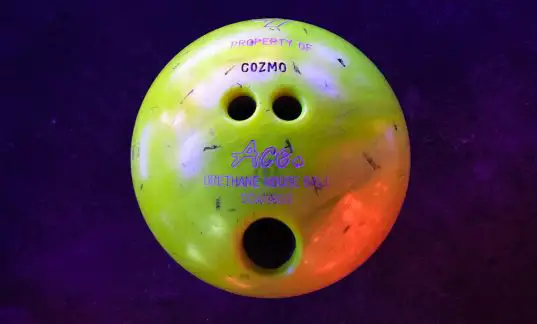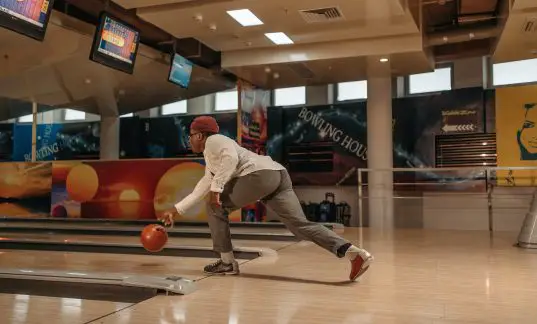Bowling balls are more than just heavy objects with holes drilled into them. They are delicately-balanced pieces of advanced equipment tailored to the needs of today’s bowlers.
Are you completely confused by your ball’s motion down-lane? Are you unsure what goes into making your bowling ball the strike standout it is today?
Let’s dive deep into how bowling balls are made — the process to make them, the standards they have to adhere to, and the types of bowling balls available for sale right now!
How are modern-day bowling balls made?
A step-by-step guide to how modern bowling balls are made.
1) Bowling ball manufacturers fashion the core shape for the new bowling ball via a computer design program. They use this design to create a bowling ball core mold.
2) The manufacturer feels the mold with iron oxide and/or calcium oxides, along with other compounds to harden the core into shape.
3) If the core is ceramic, it will be fired in a kiln to finish. If it’s a core with multiple layers, one hardened core will be placed into another mold so other compounds can be added.
4) Once the core is finished, the core is placed into a coverstock mold and held in place by a pin.
5) The outer core materials are poured directly into the mold, surrounding the bowling ball core. Depending on the ball, the coverstock will likely be 1 to 2 inches thick.
6) The pin used to hold the core in place leaves a hole in the coverstock for inserting filler material into the ball. A plastic dowel is placed into the hole and adhered into place.
7) The manufacturer uses the dowel to fill the ball with the proper amount of filler materials. This might be glass beads, polyurethane chunks, or some other compound essential to protecting the inner core.
8) The ball is turned on a lathe, shaved until it reaches the proper size and shape specifications dictated by the manufacturer and USBC regulations.
9) The manufacturer sands the ball to give it the proper factory box finish.
10) The ball is safely boxed, stored, and shipped to bowling ball distributors around the world.
What are the minimum and maximum bowling ball specifications that bowling ball manufacturers have to work with?
The United States Bowling Congress dictates that all new bowling balls be constructed with a diameter of 8.500-8.595 inches (21.6 to 21.8 centimeters). In addition, a bowling ball’s weight cannot exceed 16 pounds or dip below six pounds. When a bowling ball is made by a manufacturer, these standards must be upheld or the ball will not be accepted for use in sanctioned USBC events.
What are the different modern bowling ball options available today?
Reactive Resin Balls (High-Performance Bowling Balls)
If you’re looking for true hook potential at your local bowling lanes, look no further. Reactive resin bowling balls feature a complex polyurethane coverstock material calibrated to absorb oil and create more friction on the lane surface. There are three main types of reactive resin bowling balls to choose from — pearl reactive, hybrid reactive, and solid reactive balls.
No matter which you choose, a reactive resin ball’s surface promises unique (and angular) ball motion, increased performance in oily lane conditions, increased friction, and ball hook that many bowling balls with different coverstocks can’t match.
Reactive resin balls are the new top choice for ten-pin bowling lovers, dominating league and tournament play at bowling alleys around the world.
Urethane Bowling Balls
Before reactive resin balls hit the scene, urethane balls were the primary option for hook-happy bowlers. A urethane ball doesn’t offer the same surface roughness and performance in heavily-oiled lanes that a reactive ball does. But, it does offer fantastic surface hardness and pin impact capabilities when slotted into the pin pocket.
Reactive resin offerings offer more aggressive ball motion than urethane ones but lack the durability of the best urethane heavy hitters.
Polyester Bowling Balls (Plastic Balls)
Polyester balls are often the house ball of choice for bowling alleys. Usually fitted with a symmetrical core and corresponding weight blocks, polyester balls were one of the biggest evolutions in bowling ball technology. They replaced rubber balls as the top ball choice during the bowling boom of the mid-1900s, and offered increased durability and hitting power.
Nowadays, polyester bowling balls are better served as spare balls for serious bowlers and teaching tools for beginners. Since they are mostly symmetrical balls with straight-line power, they are great options for picking up single pins or slotting a ball into the pin pocket on a direct line.
What other types of bowling balls are there?
Rubber Bowling Ball
Before the advent of the polyester bowling ball, the rubber bowling ball dominated the bowling landscape. These balls lacked the advancements in bowling ball core technology and suffered from durability issues due to their lack of a true outer core. In addition, most rubber balls had abrasive finger holes that might cause damage to a player’s middle finger, ring finger, or pointer. In the current bowling world, rubber balls are usually relegated to toy status or use outside of ten-pin bowling.
Lawn Bowling Ball
For centuries, lawn bowling was much more popular than ten-pin bowling all over the world. It is still played regionally to this day with a hardened plastic ball that features a smooth surface.
Candlepin Bowling Ball
Candlepin bowling balls are the smallest of the specialized bowling balls. They can be made of wood, rubber, plastic, or some combination of those three materials. Because of the unique shape of bowling pins in candlepin bowling, it’s much harder to get strikes with a candlepin bowling ball.
Duckpin Bowling Ball
Duckpin bowling balls are a bit bigger than candlepin balls, but not by much. They are not particularly heavy balls, especially compared to a new bowling ball for the ten-pin game. Duckpin balls are often rubber balls with an added synthetic compound or two to the mix. They lack finger holes, just like candlepin balls.
Frequently Asked Questions
How do bowling ball cores affect the weight of a bowling ball?
A bowling ball’s core is where most of the weight is concentrated. Often made of iron oxide (or something similar) hardened with a resin compound, bowling ball core shapes come in symmetric and asymmetrical forms. The core shape doesn’t affect the actual weight of the ball, but it does affect its weight displacement rolling down the lane.
What is the best type of bowling ball for an intermediate or advanced bowler?
The friction created by a great reactive resin bowling ball makes it an unmatched option for intermediate and advanced bowlers, especially when talking about a strike ball. Add in a weight block or two that help alter its hook trajectory, and you have a pin-carry machine on your hands. For a spare ball, intermediate and expert players should consider a plastic or urethane ball — depending on the level of hook desired.
Do modern balls last longer than older rubber balls?
No. Rubber balls could last for decades upon decades if properly cleaned. Nowadays, a good reactive resin ball offers about 5-10 years of proper use at best. That’s because of the intricate tactile technology and oil absorption necessary to combat today’s bowling lane conditions. If you’re in the market for your own ball, just know that protecting your investment with proper cleaning and maintenance is crucial for extending its usage life.
Closing Thoughts
Now that you know how bowling balls are made and what kind of bowling balls there are to choose from, it’s time to hit the lanes. From house balls to high-performance hook artists, there’s a bowling ball out there for bowlers of all ages, skill levels, and frequencies of play!


